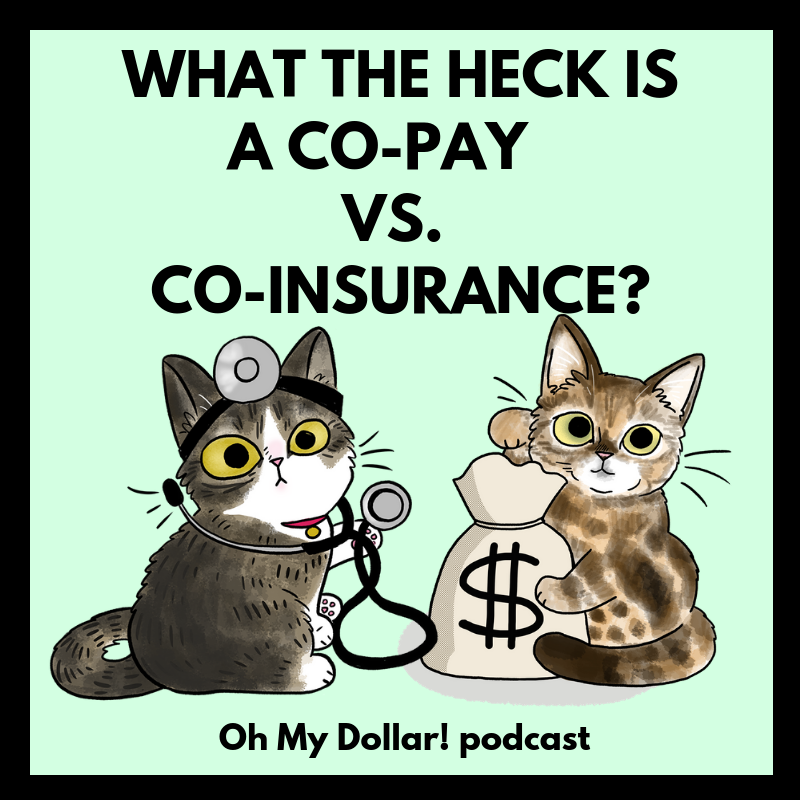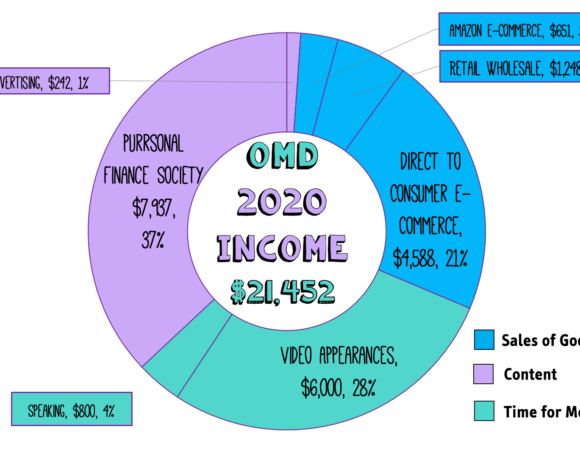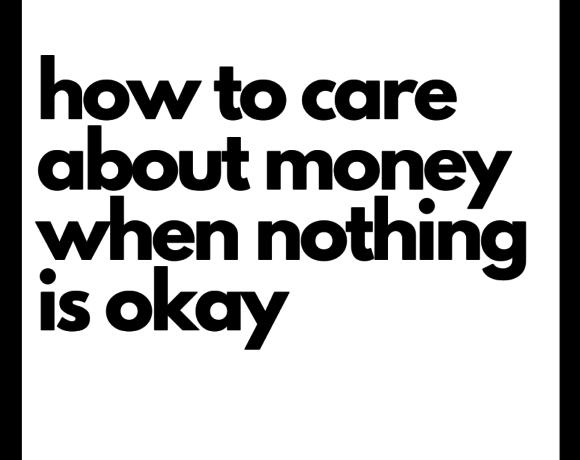This is our first ever video version of the podcast, and 1) I clearly should not be given a green screen to play with (I inserted a video of my cat napping behind me) and 2) we definitely are on a learning curve. We’ll only improve though! Thanks for your patience!
We talk about:
- What the difference is between a co-pay vs co-insurance
- How to figure out which plan is best for you
- What a co-pay before or after deductible is
- Listener question of the week: How to take advantage of good health insurance while yo have it
Why is American Health Care So Broken? headlines of the week
- Kaiser Health News Reports on how not giving low-income people health insurance is killing them in The Deep Divide: State Borders Create Medicaid Haves And Have-Nots
- Bloomberg reports that family health care coverage now tops $20,000 annually for employers.
We’ll continue this discussion on the Oh My Dollar forums, a friendly, nonjudgemental online community about money – come join us, we’re nice! This month we’re doing Budgetober, and it’s not too late to join and get your budget on track this month! While Budgetober is halloween-themed, we’re not spooky or scary, come join!
Question to discuss:
- Have you ever had any nasty surprises from co-pays vs co-insurance?
We love hearing from you!
Email us any financial worries, successes, or health care questions at questions@ohmydollar.com or tweet us at @anomalily or @ohmydollar.
A Cat’s Guide To Money – Oh My Dollar! cat-filled purrsonal finance book, is shipping now. You can order a copy now if you missed the kickstarter! (Plus new stickers and a planner!)
This show is made paw-sible by listeners like you
We absolutely love our Purrsonal Finance Society Members, the folks that generously support Oh My Dollar with $1 or more a month on Patreon – and have made is so we have free, full transcripts for every show.
This episode was underwritten by patron Tamsen G Association, Chris Giddings, and Warrior Queen. To learn more about being part of the Purrsonal Finance Society and get cool perks like cat stickers, you can visit ohmydollar.com/support
Other Episodes You Might Find Interesting
- Open Enrollment is like playing Dungeons & Dragons… with a drunk dungeon master
- Are Health Savings Accounts an evil Republican tax loophole or actual magic?
- Save money on dental – with or without insurance
Full Show Transcript (provided by our patrons)
What the heck is a co-pay vs co-insurance_.mp3 transcript powered by Sonix—the best audio to text transcription service
What the heck is a co-pay vs co-insurance_.mp3 was automatically transcribed by Sonix with the latest audio-to-text algorithms. This transcript may contain errors. Sonix is the best way to convert your audio to text in 2019.
Lillian Karabaic:
Listeners like you make this show possible and keep our lights on. You can join up with other Oh My Dollar! community members to support episode transcripts and more by making a pledge of $1 or more per month and get cool perks like cat stickers and a special badge on our forums. This episode was underwritten by the Tamsen G Association, Association, Warrior Queen and Chris Giddings. To learn more, you can visit ohmydollar.com/support
Lillian Karabaic:
Welcome to Oh My Dollar, a personal finance show with a dash of glitter. Dealing with money can be scary and stressful. Here we give practical, friendly advice about money that helps you tackle the financial overwhelm.
Lillian Karabaic:
I’m your host, Lilian Karabaic and its health care month! As you may have noticed, today, we are here in video form as well as audio form.
Lillian Karabaic:
So if you are listening to the audio version, you can also check out a video version by clicking the link in the show notes. Otherwise, if you’re here for video, welcome!
Lillian Karabaic:
We’re still figuring this out. So.
Lillian Karabaic:
But it’s time for our third annual health care month. And let me tell you, covering American health care is getting more and more depressing each year. I’m having a great time with it.
Lillian Karabaic:
We ask people every year to send in their questions about health care and what their general issues are with it. And this year is no exception to making me more and more depressed. So today
Lillian Karabaic:
we’re going to answer a common question that people have, which is what is the difference between co-pays and co-insurance?
Lillian Karabaic:
Like many things involved in health care, they make up weird names that confuse you and sound the same, so that you have really no idea what’s going on. And it’s one of those things where it can make the difference between tens of thousands of dollars, if you don’t know what you’re getting into.
Lillian Karabaic:
So it’s good to know what the difference between co-pay and co-insurance is when you are shopping for a new plan or you’re trying to pick a plan at work. So generally the first thing to know is that co-pays and co-insurance are what are considered cost-sharing measures, which means that the health insurance company pays part of it and you pay part of it.
Lillian Karabaic:
As you may discover, that is not always true. Sometimes it just means that you pay all of it. But co-payment is a term you’re probably familiar with. That’s usually what you pay if you go pick up a drug at the pharmacy or what you pay when you go visit for a doctor’s appointment.
Lillian Karabaic:
And depending on the type of insurance you have, that co-payment might be $0. It might be $5. It might be a hundred dollars.
Lillian Karabaic:
And co-payments completely vary based on not only your health insurance plan, but the type of thing you’re getting.
Lillian Karabaic:
So when, you look at the list for different types of co-pay and co-insurance, which should be included in the prospectus for your health insurance.
Lillian Karabaic:
So if you’re on healthcare.gov, you should be able to find it in the list on healthcare.gov or your state exchange or it should be presented to you in a table when you’re choosing your health insurance at work.
Lillian Karabaic:
So you should have this information in front of you about co-pay versus co-insurance. The co-payment will- There’s two ways that it can be applied. Copayment can either be before deductible or after deductible.
Lillian Karabaic:
Deductible, as we’ve talked about before, is the amount that you as an individual are responsible for paying before your health insurance kicks in. However, there’s a number of things that on a ACA compliant health insurance plan will actually generally have no co-payment or you won’t be required to pay the entire amount before you hit the deductible.
Lillian Karabaic:
So when you’re looking through co-payment, you want to look for it. If it says deductible applies. That means if you have a five hundred dollar deductible, you’re going to be responsible for paying five hundred dollars worth of services or drugs before the co-payment kicks in.
Lillian Karabaic:
So if you have, say, a twenty five dollar co-payment on your monthly medication, but it says deductible applies. That means you’re gonna have to pay the full amount of your medication until you hit that five hundred dollars.
Lillian Karabaic:
So if your co-pay is only $25, but the drug actually costs one hundred and fifty dollars a month, then that means that you’re going to hit your deductible after paying one hundred and fifty dollars until it hits five hundred dollars.
Lillian Karabaic:
So in that case, generally it would be by the fourth month of the year if the only thing you were getting was a monthly medication. Then you would hit your deductible and then the co-pay would kick in.
Lillian Karabaic:
For a lot of other drugs, there is what’s called a co-pay before deductible and you’ll see, you know, dollar co-pay before or after deductible written on your policy.
Lillian Karabaic:
And the great part about that is that means you don’t have to hit your deductible. That is very helpful if you’re on a high deductible plan.
Lillian Karabaic:
So my deductible on my plan is $6000, which means that I would probably be paying for co-pays all year long if I didn’t hit it. (And if my medication was not $5800 a month, which is a different story.)
Lillian Karabaic:
But the great thing about kind of knowing the difference between the two is it gets you a better idea of what you actually have to budget out if you know what that is.
Lillian Karabaic:
One of the most frustrating things can be is, oh, you just have a cold. You just want to go get, you know, some basic drug for your cold that requires you to get a prescription. Well, it turns out that’s a five hundred dollar cold because you have a five hundred dollar deductible and you needed to go to the doctor, pay the full cost of seeing the doctor and also pay the full cost of that medication.
Lillian Karabaic:
And then you hit your deductible. And theoretically, your health care would be a lot less the rest of the year. But it can be very frustrating, because you don’t wanna go to the doctor if you know it’s going to cost you five hundred dollars. So the reduced flat fee of a copayment really, really can vary.
Lillian Karabaic:
And this is one of those things where it’s very important to look into.
Lillian Karabaic:
And one of the big areas where this can trip you up is often there’ll be a certain kind of co-pay for going to a doctor and you’ll be like, oh, great, I only have to pay $25 when I go to the doctor.
Lillian Karabaic:
But there’s a different co-pay for a “specialist.” So I’m in the case where the vast majority of my health care providers are specialists because I have a rheumatologist and my specialist co-pay is actually $200 to see a specialist versus twenty five dollars to see my primary care physician.
Lillian Karabaic:
However, my rheumatologist is the only one who can actually see me for most things or prescribe the medication I’m on. So it’s important to be aware of that. A lot more kinds of doctors than you might think are considered specialists sometimes OB-GYNs are considered specialists, not always under all health insurance plans.
Lillian Karabaic:
So just be aware.
Lillian Karabaic:
If you are on an ACA compliant plan. There are things that can always be covered with no co-payments, so that is your annual physical checkup should have a co-payment of zero regardless of what your normal co-pay is to see the doctor. Certain kinds of screenings should be covered if you’re at a certain age, on ACA. And additionally annual well-women exams and some other kind of OB-GYN care for folks can be covered with no co-pay and deductible. It’s worth looking into.
Lillian Karabaic:
Now, that we’ve unpacked all of the fun with co-payment, what is co-insurance? Well, plans might have co-insurance or co-payment or they might have both.
Lillian Karabaic:
So co-payment is always set at a flat fee. The flat fee varies based on the type of service that you’re getting. So, you know, $50, $100, $200, but co-insurance is a percentage.
Lillian Karabaic:
So, it is a form of cost sharing that is set at a percentage. This is where it can get really tricky because paying co-insurance on something really expensive like a hospital visit or an urgent care visit, really super-duper adds up.
Lillian Karabaic:
So, for example, a health insurance plan might say that you have 20 percent co-insurance after you hit your deductible. So, if you have a $1000 E.R. visit, which unfortunately would be a really cheap E.R. visit in the states – then you would, if you had a 20 percent co-insurance, that would mean you would be responsible for two hundred dollars of it.
Lillian Karabaic:
This is one of those cases where you may actually have co-insurance and co-pay for the same visit. Real frustrating, but this is generally true. So if you rack up a surgery bill and your medical service costs $10,000 and you have a 20 percent co-insurance, you would pay $2,000.
Lillian Karabaic:
However, this is where it’s important to note your out-of-pocket maximum and you can have two different out-of-pocket maximums. You can have an in-network and out-of-network. So if you’re on what is called a PPO, which is a preferred provider organization, which is the most common form of health insurance in the states, often providers can be considered “in network” or “out of network”.
Lillian Karabaic:
Sometimes your co-insurance costs for out-of-network can be as much as you are expected to pay 100 percent, which at that point I’m not sure why it’s called insurance.
Lillian Karabaic:
But OK.
Lillian Karabaic:
The fun fun part about dealing with in-network and out-of-network is that if you go in for something like a surgery or hospital care, you may not have control over whether or not the providers are considered in or out of network. This isn’t just true for emergency services. I broke my wrist this year.
Lillian Karabaic:
I had no control even though I went to a hospital operated by my insurance plan. There was a high risk that a specialist that was involved in the surgery who I had no choice in may be out-of-network. Very common for anesthesiologists and types of providers like that to be out-of-network.
Lillian Karabaic:
And you usually don’t have a choice. So you might pay a different percentage. But your saving grace here is what is called the “out-of-pocket maximum.”.
Lillian Karabaic:
And if you’re on an ACA compliant plan, you will have to have an out-of-pocket maximum. And that out-of-pocket maximum can’t be any higher than like seven thousand five hundred a year, I believe, for the year 2020. (If it is an ACA compliant plan.).
Lillian Karabaic:
And the good news in that case is if your co-insurance hits above, you know, if you end up having something very costly happen to you or something, you know, just your drug is really expensive or something like that, you will hit your out-of-pocket maximum even if your co-insurance is really high. So that is extremely helpful to know. Sometimes co-pays don’t count towards your deductible as well, which is really fun.
Lillian Karabaic:
So if you have one of those plans where your co-insurance or co-pay exists before you hit the deductible, occasionally that will not count towards your deductible, which is just a really fun thing they can do.
Lillian Karabaic:
So this is just – can you tell, I’m just losing my will to live as I discuss what it takes to stay alive in the United States?
Lillian Karabaic:
So those are the basics on co-pay versus co-insurance. The great news is that the co-pays, because they are flat fees, they can really help you predict what your health care costs are going to be, especially if you’re on just kind of a regular drug that, you know, it is going to be.
Lillian Karabaic:
The downside of both co-pay and co-insurance is that they really, really can add up over time.
Lillian Karabaic:
And sometimes there if you have a high deductible plan, they might be irrelevant to you because you’ll never actually hit that deductible and they’re only after deductible. All right.
Lillian Karabaic:
For our next segment, we have a listener question, which I think is a bit more uplifting.
Lillian Karabaic:
Jennifer asks, “I realize this is a good problem to have, but I currently have really good insurance with no premium and reimbursements for co-pays and deductibles.”
Lillian Karabaic:
(Lily: which is awesome.)
Lillian Karabaic:
“It includes vision, dental and medical. I’m in good health overall. I have asthma, but it is very well managed and I only rarely need treatment. I don’t expect to have this kind of coverage forever, though, knowing how benefits tend to get eaten away, even if I do stay at this job. If you have a good plan, what’s the best way to make use of it while you have it?”
Lillian Karabaic:
This is a really excellent question, Jennifer. This also comes up for a lot of our younger listeners that might be under 26 and they’re on a parent’s plan that once you know, you’re older than 26, you might get kicked off your parent’s plan.
Lillian Karabaic:
But sometimes you’ve got a parent with a really great health insurance plan. And so they’re like, what can I do to take advantage of this before I get there? There’s a couple things that you can do. I mean, it’s great.
Lillian Karabaic:
One, if you’re in generally great shape and, you know, don’t go out seeking trying to get buy more health care just because you can.
Lillian Karabaic:
But there are some things that you can stock up on while you can take advantage of it. First one is this is true, whether or not you have, you know, a “Cadillac plan”, as they call them or not, make sure to take advantage of any preventative screenings.
Lillian Karabaic:
This is true for anyone that has ACA compliant coverage because it does include annual preventative screenings, including certain kinds of STI screenings and stuff like that that you can get.
Lillian Karabaic:
That’s also true at certain ages for breast cancer screenings, prostate cancer screenings. So it’s just helpful to know about that. If you do wear glasses or contacts or if you use something like inhalers, like Jennifer is asthmatic, you can often stock up.
Lillian Karabaic:
So make sure that you can kind of get your maximum. Contacts or one of those things where, you know, some – I had really good vision insurance and I bought myself a two year supply of contacts, which is just very helpful because they’re very expensive to buy on your own.
Lillian Karabaic:
But you can think out of the box. There’s some more expensive things you can get done that depending on how good your health insurance plan, it may cover it. Therapeutic massages are one. So if you need something like PT or therapeutic massage, you might be able to get it on your plan.
Lillian Karabaic:
Fertility testing is not covered by the vast majority of insurance plans, I would say. But there are some that do. So even fertility testing, that’s just trying to figure out what your egg count is or something like that, whether or not you’re actively trying to procreate at that moment in time.
Lillian Karabaic:
Some of that stuff is information that you can just arm yourself with. And then one of the ones that I’ve seen a lot of folks doing is allergy treatment. So the testing for allergies can be really expensive.
Lillian Karabaic:
And if you don’t like needles, not that fun. But you can actually go get a bunch of different kind of testing to see what you are allergic to. You may not know that you’re allergic to some things.
Lillian Karabaic:
And there’s even some like shot regimes that you can do that can cure or heavily treat some allergies, such as allergies to cats or dogs, mold – things that might make yourself miserable, if you know you want to pet cute kitties or you have to deal with mold in your house because you live in the Pacific Northwest and it’s always raining.
Lillian Karabaic:
So, this could be one of those things where it’s great to kind of stock up on, you know, preventing future allergies. If you have that.
Lillian Karabaic:
In the end, I think it’s just great to know that you have the safety net of having good insurance right now. I don’t think you need to feel like you’re missing out if you don’t take advantage of it beyond just making sure that, you know, you do that preventative screening and take care of yourself.
Lillian Karabaic:
Right after this break, we will have our new segment on depressing health care headlines in America.
Lillian Karabaic:
Just a reminder that Oh My Dollar! is supported by listeners like you through our patreon, also known as the Purr-sonal Finance Society. Folks that pledge a dollar or more gets cat stickers, perks on our forum and more. You can learn more at ohmydollar.com/support/.
Lillian Karabaic:
Time for our new segment. Why is American health care so freakin broken?
Lillian Karabaic:
Our first story is a American health care is getting even more expensive and killing people!
Lillian Karabaic:
As part of the health care reforms under the Affordable Care Act, which was passed in 2010. The low income health care program known as Medicaid was set to be expanded extended to all Americans, earning up to one hundred and thirty eight percent of the federal poverty level.
Lillian Karabaic:
The federal poverty level is around $17,000 annually for a single adult. Without the ACA’s expansion, adults who aren’t 65 or older or disabled usually do not qualify for Medicaid in most states, no matter how low their income. Missouri’s program generally only covers pregnant women and children from low income families. Parents with incomes about 22 percent of the federal poverty line, so quite low and people who are blind, disabled or 65 or older. Thirty six states did expand Medicaid to include more of their low income residents, Up to one hundred and thirty eight percent of the poverty line.
Lillian Karabaic:
But because of the court case that happened in 2014, there are a number of states that were holdouts who essentially have created arbitrary lines between low income people with health insurance and without.
Lillian Karabaic:
A new study, looked at essentially mortality rates and health care outcomes in states that border that had Medicaid expansion versus not Medicaid expansion.
Lillian Karabaic:
A recent University of Michigan study found that Medicaid expansion substantially reduced mortality rates from 2014 when it was implemented until 2017. The researchers said Illinois avoided 345 deaths annually, while its neighbor Missouri had one hundred and ninety four additional deaths each year.
Lillian Karabaic:
The same trends held true for other side by side states such as Kentucky, which did expand Medicaid, and Tennessee, which did not. It held true as well for New Mexico, which had a Medicaid expansion, and Texas, which did not. Once again showing that, it turns out when you get people health care, when they’re low income, they die less.
Lillian Karabaic:
In our next depressing story, American health care is even more expensive now. Family health care coverage now tops its highest point ever at $20,000 annually for employers.
Lillian Karabaic:
While employers pay most of the cost of coverage, according to the survey, workers average contribution is now six thousand dollars for a family plan.
Lillian Karabaic:
That’s just their share of upfront premiums. Their monthly premium payment.
Lillian Karabaic:
And does not include co-payments, co-insurance, deductibles or any other forms of cost sharing once they need care.
Lillian Karabaic:
In firms where more than 35 percent of employees earn less than twenty five thousand dollars a year, workers would have to contribute more than seven thousand dollars for a family health care plan.
Lillian Karabaic:
Only a third of employees at lower income firms are on their employer’s health plans, compared with 63 percent at higher wage firms, according to the Kaiser Family Foundation data.
Lillian Karabaic:
Deductibles are rising even faster than premiums, meaning that overall patients are on the hook for even more costs of medical. For a single person, the average deductible in 2019 was one thousand three hundred ninety six dollars, up from five hundred and thirty three in 2009.
Lillian Karabaic:
A typical household with employer health care coverage spends eight hundred dollars a year in out-of-pocket costs now, not including their portion of premiums, according to research from the Commonwealth Foundation
Lillian Karabaic:
At the high end of the range. These costs can top $5,000 a year. Some large employers have reversed course on asking workers to take on more costs, according to a separate survey from the National Business Group on Health.
Lillian Karabaic:
In 2020, fewer companies will limit employers to so-called consumer directed health care plans, which is just a different name for high deductible health care plans,
Lillian Karabaic:
Previously, employers were trying to push more of these on their employees by using various incentives, including contributing to a health savings account as an effort to lower this overall cost.
Lillian Karabaic:
This will now be the only plan at 25 percent of large employers in the survey. But this is down from 39 percent in 2018, when a lot of employers were trending to so-called “consumer-directed” health care plans.
Lillian Karabaic:
Here’s the thing. Employers still need to retain and attract employees. So for all their hemming and hawing, they’re still figuring out other ways to keep health insurance coverage lower cost to employees.
Lillian Karabaic:
That makes them more inclined to make aggressive moves to tackle underlying medical costs, such as cutting high cost hospitals out of their networks.
Lillian Karabaic:
In recent years, employers health care costs have remained steady as a share of their overall total compensation expenses, showing that probably, in general people are getting more and more health care coverage costs and less and less wages.
Lillian Karabaic:
Well, I think that’s an exciting note to end our show on today.
Lillian Karabaic:
We love hearing from you. E-mail us your financial worries or successes or any health care questions that you have this health care month at questions@ohmydollar.com.
Lillian Karabaic:
You can always tweet us at @anomalily or @ohmydollar
Lillian Karabaic:
Oh My Dollar! is recorded at XRAY FM Studios in Portland, Oregon. And we are syndicated through PRX. The episode was engineered by Tony Scholl Our videographer is Chase Spross. Our intro Music is by Aaron Parecki And I’m your host and personal finance educator, Lillian Karabaic.
Lillian Karabaic:
Thank you for listening. Until next time, remember to manage your money so it doesn’t manage you.
Quickly and accurately convert audio to text with Sonix.
Sonix uses cutting-edge artificial intelligence to convert your mp3 files to text.
Thousands of researchers and podcasters use Sonix to automatically transcribe their audio files (*.mp3). Easily convert your mp3 file to text or docx to make your media content more accessible to listeners.
Sonix is the best online audio transcription software in 2019—it’s fast, easy, and affordable.
If you are looking for a great way to convert your mp3 to text, try Sonix today.






